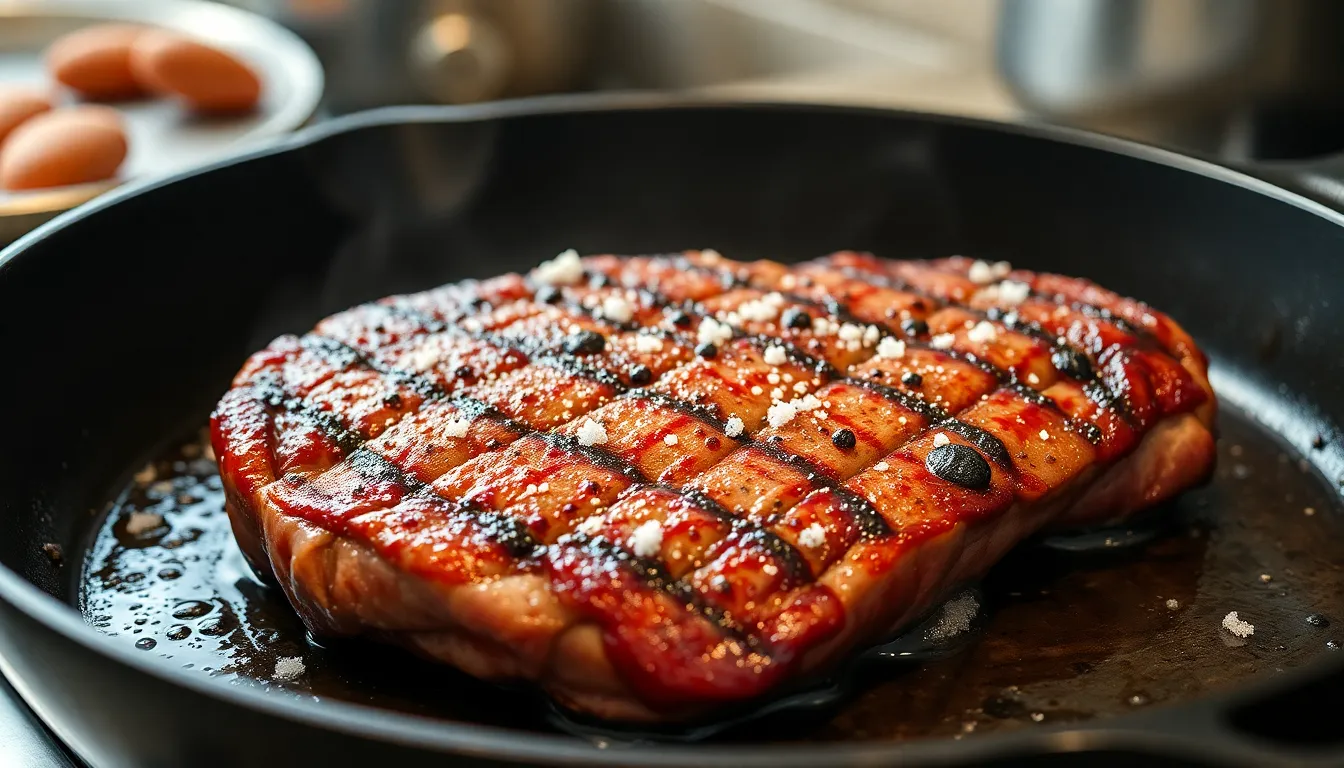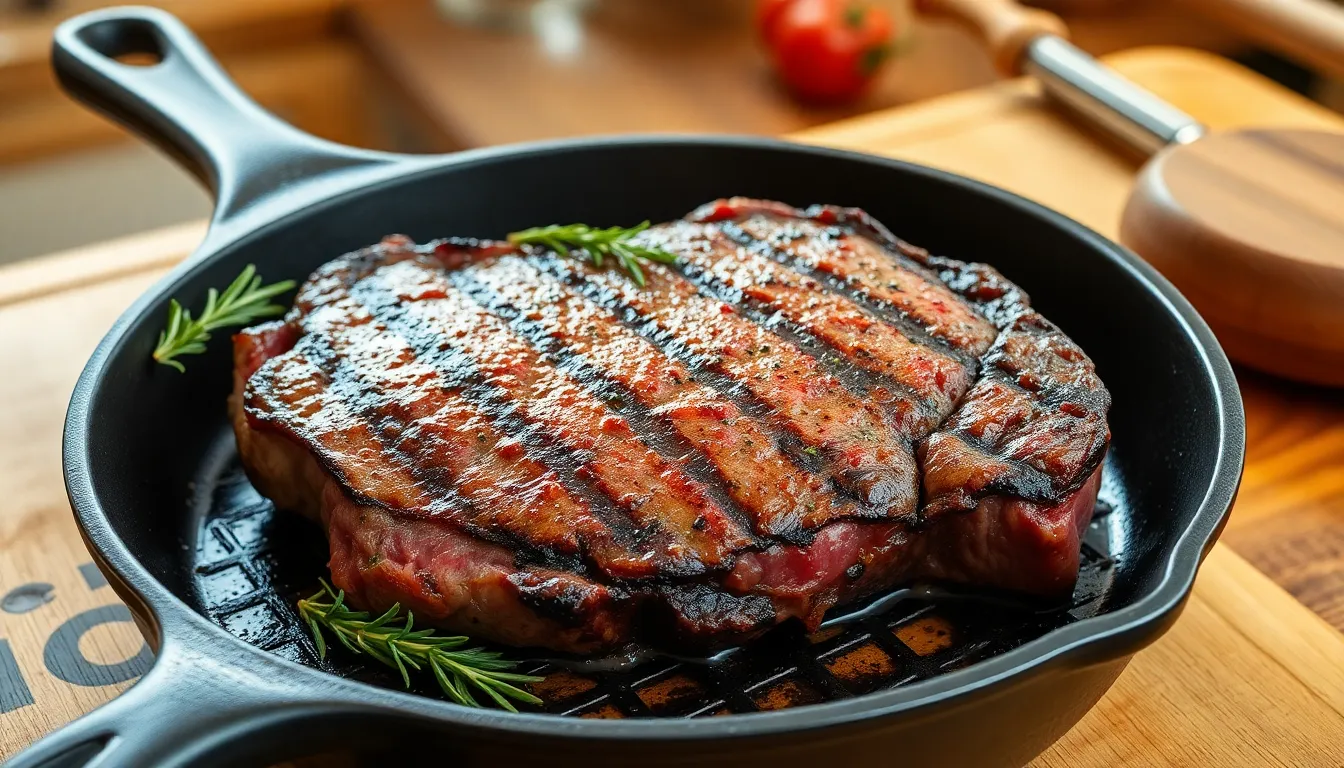Searing steak is like giving a warm hug to a beautiful cut of meat. It’s that magical moment when the heat transforms a simple steak into a mouthwatering masterpiece. Picture this: a perfectly golden crust, sizzling sounds that make your stomach growl, and an aroma that could make even the most dedicated vegetarian reconsider.
Table of Contents
ToggleUnderstanding Searing Steak
Searing steak involves applying high heat to the meat’s surface. This process creates a flavorful crust while locking in juices for a tender bite.
What Is Searing?
Searing represents the technique of cooking meat at high temperatures. The Maillard reaction occurs as sugars and amino acids react, producing browning and flavor. This reaction typically starts around 300°F, transforming the steak’s outer layer while keeping its interior moist. Searing benefits various cuts, from ribeye to filet mignon, enhancing their natural flavors and textures.
Importance of Searing in Cooking
Searing plays a crucial role in flavor development. The golden crust not only provides visual appeal but also contributes to complex taste profiles. It creates a barrier that retains moisture, ensuring steaks remain juicy and flavorful. Furthermore, searing enhances the overall dining experience, elevating a simple cut of meat into a gourmet dish. Chefs often emphasize this technique, recognizing its ability to transform the ordinary into extraordinary.
Techniques for Searing Steak

Effective searing requires attention to detail and quality ingredients. Incorporating the right elements enhances the overall experience.
Choosing the Right Cut
Selecting a quality cut is essential for optimal results. Ribeye, strip steak, and filet mignon are excellent choices due to their marbling and tenderness. Thicker cuts, typically around 1 to 1.5 inches, retain juices better during cooking. He should prioritize freshness, searching for bright red colors and minimal blemishes. Aged steaks can enhance flavor; consider the aging process when selecting a specific cut for searing.
Prepping the Steak
Preparation plays a crucial role in searing success. First, pat the steak dry with paper towels to eliminate excess moisture. This ensures a better crust forms during cooking. Then, season generously with kosher salt and freshly cracked black pepper; these enhance natural flavors. Letting the steak sit at room temperature for at least 30 minutes before cooking promotes even cooking. Marinating or applying dry rubs can elevate flavor profiles further but should be done with caution, so the natural taste of the steak shines through.
Ideal Cooking Equipment
Using the right equipment simplifies the searing process significantly. A cast iron skillet or stainless steel pan retains heat well, delivering a beautiful sear. An infrared grill or broiler is also effective for achieving high temperatures. Choosing a heavy-bottomed pan contributes to better heat distribution. High smoke point oils, such as canola or grapeseed, are recommended for frying rather than butter, which can burn quickly. Thermometers help monitor doneness, ensuring a perfect pull from the heat at the desired temperature.
Tips for Perfectly Searing Steak
Perfectly searing steak requires attention to detail and proper technique. Following specific steps ensures a juicy and flavorful result.
Achieving the Right Temperature
Start with a properly preheated pan, reaching temperatures between 400°F and 500°F. Using a cast iron skillet optimizes heat retention and distribution. After seasoning, the steak should sit at room temperature for about 30 minutes, allowing for even cooking. Employing a reliable instant-read thermometer helps gauge internal temperatures accurately. Aim for 130°F for medium-rare, as resting will continue to cook the steak slightly.
Timing and Flip Techniques
Flipping the steak only once promotes better browning and crust formation. Guidelines suggest searing each side for approximately 3 to 4 minutes, adjusting timing based on thickness. After the first flip, the steak can cook for 3 more minutes to develop the perfect crust. Patience plays a key role; avoid pressing down on the steak while searing, as this releases valuable juices. Monitoring cooking time closely contributes to achieving the desired doneness.
Flavor Enhancements
Incorporating aromatic herbs and spices elevates the steak’s flavor. Consider adding thyme or rosemary during cooking for an aromatic boost. Infusing butter into the pan halfway through the cooking process enriches the taste further. Using high-quality salts emphasizes the natural flavors of the steak. A squeeze of lemon juice after cooking brightens and complements the richness. Each of these enhancements contributes to a more delicious dish.
Common Mistakes to Avoid
Searing steak demands precision and care. Avoiding common pitfalls enhances the final dish significantly.
Overcrowding the Pan
Overcrowding the pan leads to steaming instead of searing. Each steak needs ample space for heat circulation. When too many pieces sit together, they prevent proper browning. Ideally, sear one or two steaks at a time, depending on pan size. This method ensures that each steak develops a flavorful crust. For larger meals, work in batches to maintain optimal temperature and texture.
Using the Wrong Fat
Using the wrong fat can hinder the searing process. High smoke point oils, such as avocado or canola oil, withstand high temperatures. Butter, while flavorful, burns quickly due to its milk solids. Combining butter with a suitable oil creates the best of both worlds, allowing for flavor enhancement without burning. Prioritize oils that complement the meat’s natural flavors while providing the necessary heat tolerance.
Neglecting Rest Time
Neglecting rest time leads to a less juicy steak. After cooking, resting the meat allows juices to redistribute throughout. For optimal results, let the steak rest for at least five minutes before slicing. Skipping this step can result in dry pieces, as cutting too soon forces juices to escape. A properly rested steak showcases its tenderness and flavor, elevating the overall dining experience.
Searing steak is an art that transforms a simple cut of meat into a culinary masterpiece. By mastering the techniques and paying attention to details, anyone can achieve that perfect golden crust and juicy interior. The right choice of cut, proper seasoning, and the use of high-quality oils are essential for success.
Avoiding common pitfalls like overcrowding the pan ensures that each steak gets the attention it deserves. With a little patience and practice, the rewards are undeniably delicious. Whether it’s for a special occasion or a weeknight dinner, a perfectly seared steak is sure to impress.




